11355 A FINE GEORGE III WEST INDIAN SATINWOOD COMMODE OF MOST UNUSUAL OVAL FORM ATTRIBUTED TO GILLOW & CO. English. Circa 1790. Measurements: Height: 34″ (86 cm) Width: 42 1/2″ (108 cm) Depth: 21 1/2″(55 cm) javascript:void(0);
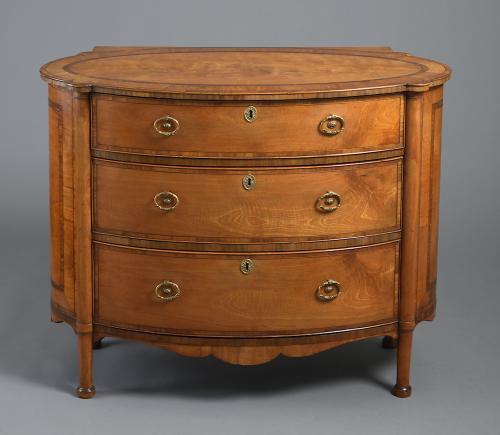
Research
Of satinwood with hardwood veneered banding. The crossbanded oval top rests on a confirming base. Fitted with three crossbanded drawers mounted with finely cast giltbrass oval drop handless centered by an independent brass paterae. The drawers flanked by plain columnar styles and curved ends the whole resting on plain cylindrical feet. The key escutcheons of a later date.
The present commode, with its complex oval form, seems to be without precedent in the canon of English eighteenth century furniture. It would have been a piece of exceptional cost and difficulty to construct, and was perhaps conceived as a prestigious ‘masterpiece’ that showed off the dexterity of the preeminent Gillows & Co. furniture makers.
The Gillows firm had been founded in the years around 1730 by Robert Gillow in his native Lancaster, providing a concentration of clients for whom the firm worked in north-western England. The establishment by his son, Robert II, of a major London branch on Oxford Street in 1769 gave the firm “easier access to information on trends in the capital”1 and an an influx of fashionable and aristocratic clientele. As a result, Gillows were responsible for supplying some of Britain’s greatest houses. A number of the finest pieces of furniture of the second part of the eighteenth century were made by Gillows, who worked closely with the leading architect James Wyatt and fulfilled commissions for, among others, the Earl of Wilton, the Duke of Norfolk, the Earl of Surrey and the Marquis of Westminster.2 “By the end of the century the firm was furnishing the largest mansions and townhouses completely.”3 The Gillows archive, the most comprehensive of any English furniture maker’s to survive, attests to the “range and detail of the firms huge output.”4 The company remained in the family until 1815, though later partnerships continued to use the Gillow name.
Aside from the ambitious design and construction of the present commode, one of the most precious timbers of the eighteenth century is employed here as a show wood. Almost without exception, the use of West Indian satinwood in eighteenth century furniture is indicative of pieces of the first quality. Indeed, perhaps the most iconic item of English furniture from the neoclassical period, the “Minerva Commode,” by Thomas Chippendale, was veneered in this choice wood.
As the great furniture scholar Adam Bowett points out, West Indian satinwood’s “pale, vivacious” qualities of color and figure matched well the incoming taste for light, elegant neoclassical furniture from the late 1770s to 1790s.5 Thus, its prized position among leading cabinet makers caused the timber to be valued at a multiple of the finest mahogany. “Hispanola mahogany was fetching between 8d. and 10d. at this time,” while satinwood could go for 2-3 shillings per foot.6 “The Gillows enterprise included importing…[West Indian] exotic hardwoods, and they enjoyed a worthwhile export trade in furniture to both the West Indies and the ports of northern Europe.”7
The present commode can be firmly attributed to Gillows on account of specific features it displays, principally the distinctive oval handles centered by detached paterae. This model of gilt-brass pull “[has] long been associated with the firm”8 and, indeed, another satinwood commode attributed to Gillows (sold Christie’s London, 23 May 2018, Lot 70) has this same handle, in conjunction with similarly crossbanded drawer fronts (figure 1). Furthermore, the use of distinctive 3/4 columns below a conforming lobed cornered top can be seen in Gillows’ pattern books, and this conceit can also be witnessed on a remarkable satinwood secretaire chest (figure 2). This piece, which is also somewhat experimental in form, displays the same handles as the present commode.
Footnotes:
- Shimbo, Akiko D, and Gareth P. Shaw. Furniture-makers and Consumers in England, 1754-1851: Design As Interaction. Farnham: Ashgate Publishing Ltd, 2015. 135.
- Beard, Geoffrey & Christopher Gilbert, Dictionary of English Furniture Makers 1660-1840, Leeds, 1986, pp. 341-3
- Ibid.
- Ibid.
- Bowett, Adam. Woods in British Furniture-Making, 1400-1900: An Illustrated Historical Dictionary. Wetherby: Oblong Creative, 2012. 218
- Ibid., 219
- Beard, 342.
- Susan E. Stuart. Gillows of Lancaster and London: 1730-1840 ; Cabinetmakers and International Merchants : a Furniture and Business History Vo. 2 . Woodbridge, Suffolk: Antique Collector’s Club, 2008. 324.

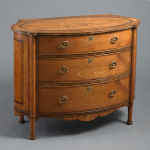
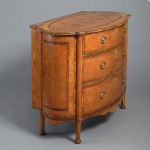

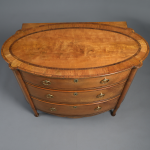
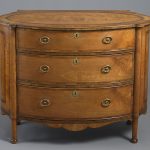
Comments are closed.